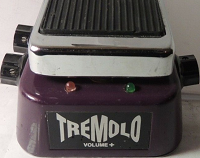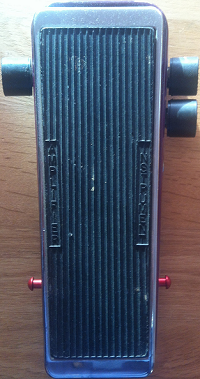Difference between revisions of "TVP-1 Tremolo"
(→Controls) |
|||
| Line 27: | Line 27: | ||
* Switch 1 (left red toggle) - '''"Modulation"''': This switch toggles between: | * Switch 1 (left red toggle) - '''"Modulation"''': This switch toggles between: | ||
** (switch-out) '''"Smooth"''' a softer sine-wave modulated tremolo, and | ** (switch-out) '''"Smooth"''' a softer sine-wave modulated tremolo, and | ||
| − | ** (switch-in) '''"Hard"''', a harder square-wave tremolo | + | ** (switch-in) '''"Hard"''', a harder square-wave tremolo. |
* Switch 2 (right red toggle) - '''"Mode Selector"''': This switch toggles between: | * Switch 2 (right red toggle) - '''"Mode Selector"''': This switch toggles between: | ||
** (switch-out) Volume Control: control volume level with the sweep of the treadle. Toe-down is maximum volume | ** (switch-out) Volume Control: control volume level with the sweep of the treadle. Toe-down is maximum volume | ||
Revision as of 01:28, 2 April 2019
Dunlop TVP-1 Tremolo/Volume pedal. This is a pedal that has fallen off the radar of most pedal enthusiasts and at first glance, it's not hard to understand why...
This is a difficult pedal to master. Just as the wah-wah, so too do the Rotovibe, and the Variphase and other treadled pedals require their own learning curve. The Rotovibe is probably the closest, function-wise, to the TVP-1 in that as the treadle is rolled from heel to toe, the modulation effect becomes faster and faster...
This is in stark contrast to the Wah-wah where the sweeping of the treadle sweeps the effect. Like the Rotovibe, when the TVP-1 is in tremolo mode, a little can go a long way.
However, there's also a couple of very useful applications of this pedal, and that's acting as sweepable volume control (instead of using the volume potentiometer on whatever instrument the pedal is plugged into)
The fact that we're unfamiliar with any music performed with this pedal in any kind of heavy music suggests two things:
- There's a challenging learning curve on using the variable tremolo speed in this pedal in a musically sophisticated and tasteful manner. The further implication is that it also suggests to us that this pedal opens a decent-sized chunk of uncharted musical territory here
- It's likely, that like the Rotovibe, not only can a little go a long way, but by extension, it's easy to overdo this pedal.
That said, we're eager to see the TVP-1 come to a full fruition.
Since TVP-1s are only available used now, prices on TVP-1s tend to vary from around $135 up to $180 or so. They aren't wildly priced "booteek vintage" pedals because it seems they never were high on anyone's attention list. That said, if you're interested in getting one, be on the lookout, some TVP-1s are very beat-up. Others are almost pristine and prices on auction sides and forums doesn't seem to correspond to the particular conditions of the pedal.
- Thermionic Studios has one(1) TVP-1 pedal available for rental.
Controls


- Knob 1 (left-side knob) - "Intensity": Adjusts how much of the tremolo effect is applied to the output, with fully clockwise being the greatest level of effect for into the tremolo effect, and fully clockwise being no more than a mild volume "throb".
- Knob 2 (right-side "upper" knob) - "Toe Down Volume": Adjusts the upper volume (output) limit with fully counter-clockwise being +0 db ("unity gain") and with fully clockwise being +6 db (boost).
- Knob 3 (right-side "lower" knob) - "Heel Down Volume": Adjusts the with fully counter-clockwise being no output whatsoever (as you would expect from a standard volume-sweep pedal) to fully clockwise at +0 db ("unity gain").
- Switch 1 (left red toggle) - "Modulation": This switch toggles between:
- (switch-out) "Smooth" a softer sine-wave modulated tremolo, and
- (switch-in) "Hard", a harder square-wave tremolo.
- Switch 2 (right red toggle) - "Mode Selector": This switch toggles between:
- (switch-out) Volume Control: control volume level with the sweep of the treadle. Toe-down is maximum volume
- (switch-in) Tremolo Function: The TVP-1 becomes a tremolo effect pedal. Toe-down is fastest "throb" speed
- Footswitch 1 - "On/Off": This footswitch toggles the pedal between engaged/active ("On"), and bypassed ("Off"). As in most treadled pedals, this switch is toggled by firm pressure when the sweep is in the full toe-down position.
Bypass: Buffered
The TVP-1 has a buffered bypass.
General Information
The easiest way to think of this pedal is that the left side of the pedal controls the the Tremolo Effect, and the right side controls the volume effect. What doesn't make a whole lot of sense is that when the Tremolo is engaged, the right light is on, and when the Volume effect is engaged, the left light is on! We'll have to change this so that it's consistent across the usage of the pedal.
So here's a "quick-start" guide on using the pedal:
Pedal Left Side: Tremolo
The tremolo effect is clearly the "splashier" effect in this pedal. As mentioned above, few, if any, have mastered the use of a variable tremolo throb for the purposes of new and interesting music.
- Quick Start Tremolo
- Make sure the Mode Selector button on the right side is pressed in toward the left side of the pedal (a simple mnemonic device) so that the left side (tremolo) effect is selected.
- Engage the pedal by clicking the On/Off button with a firm toe-down press.
- With the tremolo engaged, rocking your foot back and forth will change the speed of the tremolo effect.
- Sweeping the treadle to the heel-down position slows the tremolo throb; sweeping the treadle to the toe-down position speeds the tremolo up.
- The left knob increases and decreases the intensity of the tremolo.
- The left switch alternates between a hard full volume-off volume-full volume-off volume style tremolo, and a smoother-sloped alternating "volume sweep" tremolo.
Pedal Right Side: Volume
The right side of the pedal is actually a bit more novel and it's clear that some thought went into creating this secondary effect for the TVP-1.
Pedal Manual
We have searched in vain for a paper or electronic copy of the original owner's manual. None being found, we believe this wiki entry is most likely the best available authority on using the pedal.
Phase Inversion: Yes/No
| Schematic ID | Electronic Part | Action | Phase State |
|---|---|---|---|
| X | X | X | X |
Schematic
We are unaware of any available schematic. We shall continue to try looking for such, but as this pedal was discontinued in the 1990s and never had a large following anyway, we suspect none may be available.
Artists
We are currently unaware of any artists actively using the pedal now, or who have in the past.
- Additional Sources